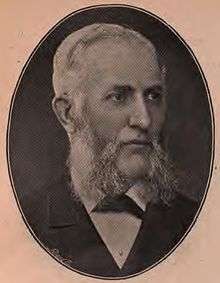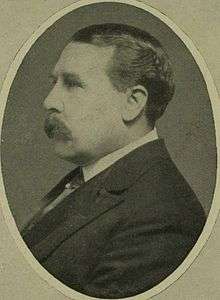Glasgow St Rollox (UK Parliament constituency)
Glasgow St. Rollox was a burgh constituency represented in the House of Commons of the Parliament of the United Kingdom from 1885 until 1950. It elected one Member of Parliament (MP) using the first-past-the-post voting system.
The constituency covered Glasgow's Cowcaddens and Woodside wards. In 1950, the constituency was extended to include North Kelvin ward, and the name was changed to Glasgow Woodside.
It is referenced in Franz Ferdinand's song "The Fallen" as an area where the protagonist of the story spends much of his time.
Boundaries
The Redistribution of Seats Act 1885 provided that the constituency was to consist of the Fifth Municipal Ward, and the Third Municipal Ward, except so much as is comprised in the Camlachie Division. [1]
In 1918 the constituency consisted of "That portion of the city which is bounded by a line commencing at a point at the intersection of Springburn Road and Parliamentary Road, thence south-westward along the centre line of Parliamentary Road to the centre line of Buchanan Street, thence northward along the centre line of Buchanan Street to the centre line of Cowcaddens, thence northwestward along the centre line of Cowcaddens, New City Road and Great Western Road to the centre line of the River Kelvin, thence northward along the centre line of the River Kelvin to the centre line of Belmont Street, thence northeastward along the centre line of Belmont Street to the centre line of Carlton Gardens, thence eastward along the centre line of Carlton Gardens and Raeberry Street to the centre line of New City Road, thence north-eastward along the centre line of Well Road and continuation thereof to the centre line of the Forth and Clyde Canal, thence south-eastward along the centre line of the Forth and Clyde Canal to the centre line of Possil Road, thence north-eastward along the centre line of Possil Road to the centre line of Saracen Street, thence eastward and north-eastward along the centre line of Keppochhill Road to the centre of the North British Railway (Edinburgh and Glasgow Line), thence south-westward along the centre line of the said North British Railway to the centre line of Fountainwell Road, thence south-eastward along the centre line of Fountainwell Road to the centre line of Springburn Road, thence southward along the centre line of Springburn Road to the point of commencement."
Members of Parliament
Election results
Elections in the 1880s

James Caldwell
Elections in the 1890s
Elections in the 1900s

McKinnon Wood
Elections in the 1910s
- endorsed by Coalition Government
Elections in the 1920s
Elections in the 1930s
Elections in the 1940s
References
- ↑ Redistribution of Seats Act 1885, Sixth Schedule
- ↑ Leigh Rayment's Historical List of MPs – Constituencies beginning with "S" (part 1)
- ↑ Debrett's House of Commons and the Judicial Bench, 1889
- ↑ Debrett's House of Commons and the Judicial Bench, 1889
- ↑ Whitaker's Almanack, 1893
- ↑ Debrett's House of Commons and the Judicial Bench, 1901
- ↑ Debrett's House of Commons and the Judicial Bench, 1901
- ↑ Whitaker's Almanack, 1907
- ↑ Debrett's House of Commons and the Judicial Bench, 1916
- ↑ Debrett's House of Commons and the Judicial Bench, 1916
- ↑ Debrett's House of Commons and the Judicial Bench, 1916
- ↑ Whitaker's Almanack, 1920
- ↑ The Times, 8 December 1923
- ↑ Oliver & Boyd's Edinburgh Almanac, 1924
- ↑ British Parliamentary Election Results 1918-1949, FWS Craig
- ↑ The Times, 9 May 1931
- ↑ Whitaker's Almanack, 1934
- ↑ Whitaker's Almanack, 1939
|
|---|
|
|
|
|
|
- Aberdeen North
- Aberdeen South
- Airdrie & Shotts
- Angus
- Argyll & Bute
- Ayr, Carrick & Cumnock
- Banff & Buchan
- Berwickshire, Roxburgh & Selkirk
- Caithness, Sutherland & Easter Ross
- Central Ayrshire
- Coatbridge, Chryston & Bellshill
- Cumbernauld, Kilsyth & Kirkintilloch East
- Dumfries & Galloway
- Dumfriesshire, Clydesdale & Tweeddale
- Dundee East
- Dundee West
- Dunfermline & West Fife
- East Dunbartonshire
- East Kilbride, Strathaven & Lesmahagow
- East Lothian
- East Renfrewshire
- Edinburgh East
- Edinburgh North & Leith
- Edinburgh South
- Edinburgh South West
- Edinburgh West
- Falkirk
- Glasgow Central
- Glasgow East
- Glasgow North
- Glasgow North East
- Glasgow North West
- Glasgow South
- Glasgow South West
- Glenrothes
- Gordon
- Inverclyde
- Inverness, Nairn, Badenoch & Strathspey
- Kilmarnock & Loudoun
- Kirkcaldy & Cowdenbeath
- Lanark & Hamilton East
- Linlithgow & East Falkirk
- Livingston
- Midlothian
- Moray
- Motherwell & Wishaw
- Na h-Eileanan an Iar
- North Ayrshire & Arran
- North East Fife
- Ochil & South Perthshire
- Orkney & Shetland
- Paisley & Renfrewshire North
- Paisley & Renfrewshire South
- Perth & North Perthshire
- Ross, Skye & Lochaber
- Rutherglen & Hamilton West
- Stirling
- West Aberdeenshire & Kincardine
- West Dunbartonshire
|

